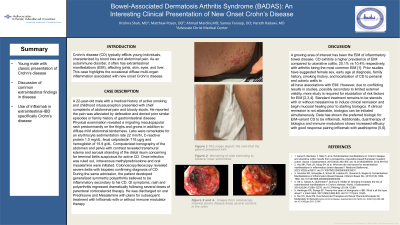Sunday Poster Session
Category: IBD
P1006 - Bowel-Associated Dermatosis Arthritis Syndrome (BADAS): An Interesting Clinical Presentation of New Onset Crohn’s Disease
Sunday, October 27, 2024
3:30 PM - 7:00 PM ET
Location: Exhibit Hall E

Has Audio

Krishna Shah, MD
Advocate Christ Medical Center
Chicago, IL
Presenting Author(s)
Krishna Shah, MD1, Matthew Posen, DO2, Harreth Raddawi, MD2, Samee Farooqi, DO2
1Advocate Christ Medical Center, Chicago, IL; 2Advocate Christ Medical Center, Oak Lawn, IL
Introduction: Crohn’s disease (CD) typically afflicts young individuals, characterized by blood loss and abdominal pain. As an autoimmune disorder, it often has extraintestinal manifestations (EIM), affecting joints, skin, eyes, and liver. This case highlights the occasional diffuse multi-organ inflammation associated with new onset Crohn’s disease.
Case Description/Methods: A 22-year-old male with a medical history of active smoking and childhood intussusception presented with abdominal pain and bloody stools. Physical examination revealed a migrating maculopapular rash predominantly on the thighs and groins in addition to diffuse mild abdominal tenderness. Labs were remarkable for an erythrocyte sedimentation rate 22 mm/hr, C-reactive protein 1.0 mg/dL, fecal calprotectin 718 ug/g and hemoglobin of 15.9 g/dL. Computerized tomography of the abdomen and pelvis with contrast revealed transmural edema and serosal stranding of the distal ileum concerning for terminal ileitis suspicious for active CD. Colonoscopy/ileoscopy revealed severe ileitis with biopsies confirming diagnosis of CD. During the same admission, the patient developed generalized symmetric polyarthritis. GI symptoms, rash and polyarthritis regressed dramatically following several doses of intravenous methylprednisolone and oral mesalamine. He was discharged on oral Prednisone and Mesalamine with plans for subsequent treatment with Infliximab with or without immune modulator therapy.
Discussion: A growing area of interest has been the EIM of inflammatory bowel disease. CD exhibits a higher prevalence of EIM compared to ulcerative colitis, 20.1% vs 10.4% respectively, with arthritis being the most common EIM. Prior studies have suggested female sex, early age at diagnosis, family history, smoking history, and localization of CD to perianal and colonic walls to all have associations with EIM. However, due to conflicting results in studies, possibly secondary to limited external validity, more study is required for elucidation of risk factors for EIM. Standard treatment remains to be steroids with or without mesalamine to induce clinical remission and begin mucosal healing prior to starting biologics. If clinical remission is not attainable, biologics can be initiated simultaneously. Data has shown the preferred biologic for EIM-variant CD to be infliximab. Additionally, dual therapy of biologics and immune modulators shows increased efficacy with good response pairing infliximab with azathioprine.
Disclosures:
Krishna Shah, MD1, Matthew Posen, DO2, Harreth Raddawi, MD2, Samee Farooqi, DO2. P1006 - Bowel-Associated Dermatosis Arthritis Syndrome (BADAS): An Interesting Clinical Presentation of New Onset Crohn’s Disease, ACG 2024 Annual Scientific Meeting Abstracts. Philadelphia, PA: American College of Gastroenterology.
1Advocate Christ Medical Center, Chicago, IL; 2Advocate Christ Medical Center, Oak Lawn, IL
Introduction: Crohn’s disease (CD) typically afflicts young individuals, characterized by blood loss and abdominal pain. As an autoimmune disorder, it often has extraintestinal manifestations (EIM), affecting joints, skin, eyes, and liver. This case highlights the occasional diffuse multi-organ inflammation associated with new onset Crohn’s disease.
Case Description/Methods: A 22-year-old male with a medical history of active smoking and childhood intussusception presented with abdominal pain and bloody stools. Physical examination revealed a migrating maculopapular rash predominantly on the thighs and groins in addition to diffuse mild abdominal tenderness. Labs were remarkable for an erythrocyte sedimentation rate 22 mm/hr, C-reactive protein 1.0 mg/dL, fecal calprotectin 718 ug/g and hemoglobin of 15.9 g/dL. Computerized tomography of the abdomen and pelvis with contrast revealed transmural edema and serosal stranding of the distal ileum concerning for terminal ileitis suspicious for active CD. Colonoscopy/ileoscopy revealed severe ileitis with biopsies confirming diagnosis of CD. During the same admission, the patient developed generalized symmetric polyarthritis. GI symptoms, rash and polyarthritis regressed dramatically following several doses of intravenous methylprednisolone and oral mesalamine. He was discharged on oral Prednisone and Mesalamine with plans for subsequent treatment with Infliximab with or without immune modulator therapy.
Discussion: A growing area of interest has been the EIM of inflammatory bowel disease. CD exhibits a higher prevalence of EIM compared to ulcerative colitis, 20.1% vs 10.4% respectively, with arthritis being the most common EIM. Prior studies have suggested female sex, early age at diagnosis, family history, smoking history, and localization of CD to perianal and colonic walls to all have associations with EIM. However, due to conflicting results in studies, possibly secondary to limited external validity, more study is required for elucidation of risk factors for EIM. Standard treatment remains to be steroids with or without mesalamine to induce clinical remission and begin mucosal healing prior to starting biologics. If clinical remission is not attainable, biologics can be initiated simultaneously. Data has shown the preferred biologic for EIM-variant CD to be infliximab. Additionally, dual therapy of biologics and immune modulators shows increased efficacy with good response pairing infliximab with azathioprine.
Disclosures:
Krishna Shah indicated no relevant financial relationships.
Matthew Posen indicated no relevant financial relationships.
Harreth Raddawi indicated no relevant financial relationships.
Samee Farooqi indicated no relevant financial relationships.
Krishna Shah, MD1, Matthew Posen, DO2, Harreth Raddawi, MD2, Samee Farooqi, DO2. P1006 - Bowel-Associated Dermatosis Arthritis Syndrome (BADAS): An Interesting Clinical Presentation of New Onset Crohn’s Disease, ACG 2024 Annual Scientific Meeting Abstracts. Philadelphia, PA: American College of Gastroenterology.
